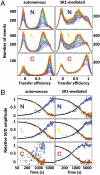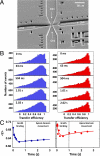Single-molecule spectroscopy of protein folding in a chaperonin cage
- PMID: 20547872
- PMCID: PMC2900638
- DOI: 10.1073/pnas.1002356107
Single-molecule spectroscopy of protein folding in a chaperonin cage
Abstract
Molecular chaperones are known to be essential for avoiding protein aggregation in vivo, but it is still unclear how they affect protein folding mechanisms. We use single-molecule Förster resonance energy transfer to follow the folding of a protein inside the GroEL/GroES chaperonin cavity over a time range from milliseconds to hours. Our results show that confinement in the chaperonin decelerates the folding of the C-terminal domain in the substrate protein rhodanese, but leaves the folding rate of the N-terminal domain unaffected. Microfluidic mixing experiments indicate that strong interactions of the substrate with the cavity walls impede the folding process, but the folding hierarchy is preserved. Our results imply that no universal chaperonin mechanism exists. Rather, a competition between intra- and intermolecular interactions determines the folding rates and mechanisms of a substrate inside the GroEL/GroES cage.
Conflict of interest statement
The authors declare no conflict of interest.
Figures






Similar articles
-
Dual function of protein confinement in chaperonin-assisted protein folding.Cell. 2001 Oct 19;107(2):223-33. doi: 10.1016/s0092-8674(01)00517-7. Cell. 2001. PMID: 11672529
-
Productive folding of a tethered protein in the chaperonin GroEL-GroES cage.Biochem Biophys Res Commun. 2015 Oct 9;466(1):72-5. doi: 10.1016/j.bbrc.2015.08.108. Epub 2015 Aug 29. Biochem Biophys Res Commun. 2015. PMID: 26325470
-
Characterization of the active intermediate of a GroEL-GroES-mediated protein folding reaction.Cell. 1996 Feb 9;84(3):481-90. doi: 10.1016/s0092-8674(00)81293-3. Cell. 1996. PMID: 8608602
-
Reaction Cycle of Chaperonin GroEL via Symmetric "Football" Intermediate.J Mol Biol. 2015 Sep 11;427(18):2912-8. doi: 10.1016/j.jmb.2015.04.007. Epub 2015 Apr 18. J Mol Biol. 2015. PMID: 25900372 Review.
-
Protein folding assisted by the GroEL/GroES chaperonin system.Biochemistry (Mosc). 1998 Apr;63(4):374-81. Biochemistry (Mosc). 1998. PMID: 9556520 Review.
Cited by
-
The dimerization domain of SARS CoV 2 Nucleocapsid protein is partially disordered as a monomer and forms a high affinity dynamic complex.bioRxiv [Preprint]. 2024 Sep 25:2024.09.25.614883. doi: 10.1101/2024.09.25.614883. bioRxiv. 2024. PMID: 39386676 Free PMC article. Preprint.
-
Biosensors for Detection of Human Placental Pathologies: A Review of Emerging Technologies and Current Trends.Transl Res. 2019 Nov;213:23-49. doi: 10.1016/j.trsl.2019.05.002. Epub 2019 May 20. Transl Res. 2019. PMID: 31170377 Free PMC article. Review.
-
Repetitive protein unfolding by the trans ring of the GroEL-GroES chaperonin complex stimulates folding.J Biol Chem. 2013 Oct 25;288(43):30944-55. doi: 10.1074/jbc.M113.480178. Epub 2013 Sep 10. J Biol Chem. 2013. PMID: 24022487 Free PMC article.
-
Mechanisms of cellular proteostasis: insights from single-molecule approaches.Annu Rev Biophys. 2014;43:119-40. doi: 10.1146/annurev-biophys-051013-022811. Annu Rev Biophys. 2014. PMID: 24895851 Free PMC article. Review.
-
Stabilization of interdomain closure by a G protein inhibitor.Proc Natl Acad Sci U S A. 2024 Sep 3;121(36):e2311711121. doi: 10.1073/pnas.2311711121. Epub 2024 Aug 28. Proc Natl Acad Sci U S A. 2024. PMID: 39196624 Free PMC article.
References
-
- Thirumalai D, Lorimer GH. Chaperonin-mediated protein folding. Annu Rev Biophys Biomol Struct. 2001;30:245–269. - PubMed
-
- Hartl FU, Hayer-Hartl M. Protein folding—Molecular chaperones in the cytosol: from nascent chain to folded protein. Science. 2002;295:1852–1858. - PubMed
-
- Bukau B, Weissman J, Horwich A. Molecular chaperones and protein quality control. Cell. 2006;125:443–451. - PubMed
-
- Ellgaard L, Helenius A. Quality control in the endoplasmic reticulum. Nat Rev Mol Cell Biol. 2003;4:181–191. - PubMed
-
- Fersht AR. Structure and mechanism in protein science. New York: W.H. Freeman and Company; 1998.
Publication types
MeSH terms
Substances
LinkOut - more resources
Full Text Sources
Research Materials

